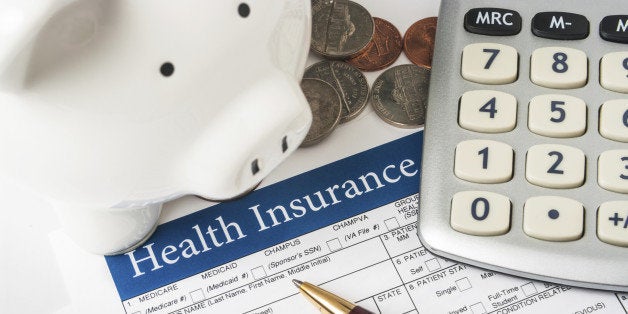
This weekly Q&A addresses questions from real patients about health care costs. Have a question you'd like to see answered? Submit it to AskChristina@nerdwallet.com.
"I'm shopping for new health insurance and confused by all of the options, specifically the difference between deductibles and out-of-pocket maximums. I'm generally healthy, in my mid-thirties and don't spend too much on medical care each year. I don't have a lot of money to spend on monthly health insurance premiums, but wonder if having a low or high deductible would be more appropriate and how the cost of each should play into my decision."
Shopping for health insurance can be confusing, but I'm happy to hear that you're educating yourself on all of the options. It's too easy to choose a plan based on your monthly premium and neglect to take things like deductibles or out-of-pocket expenses into consideration.
Your out-of-pocket expenses are important as they can easily add up, and being caught with costly medical bills can cause financial disaster. Setting aside money for unexpected health care costs should be on everyone's to-do list, but choosing the right plan can help ensure these expenses won't get the best of you. Here is some background information on what you need to understand before choosing a plan.
Common health insurance terms you should know
Many of the potentially confusing health insurance concepts describe elements of cost-sharing, or the share of costs for health services that you have to pay (as opposed to your health insurance company paying). Here are some of the more commonly misunderstood cost-sharing concepts:
Co-payment (or copay): A copay is a flat fee you pay at the time of service. This may be a $25 fee to see your doctor or a $10 fee to fill a prescription.
Deductible: The deductible is the amount of money you must pay for health services before your insurance kicks in. It's important to note that hitting your deductible doesn't mean your insurance company will pay for everything after that point. In fact, often you will still be responsible for a significant portion of fees after your deductible, while your insurance pays the remainder of the bill.
Coinsurance: Coinsurance refers to a certain percentage that you must cover, with your insurance company picking up the balance. It applies after you have met your deductible.
Out-of-pocket maximum: The out-of-pocket maximum is a cap placed on your plan that indicates the maximum amount you will pay in a given year. For 2015, plans bought on the Affordable Care Act marketplace (healthcare.gov) or the state exchanges have an out-of-pocket max of $6,600 for an individual or $13,200 for a family. This means that once you pay $6,600 (including your copays, deductible and coinsurance), your insurance company will pay 100 percent of your in-network costs. Insurance companies can set out-of-pocket maximum limits below this ACA cap.
Making sense of cost-sharing
In your health insurance shopping you likely realized that plans come with a seemingly endless combination of cost-sharing options.
Say you had to go to the hospital for one overnight and ended up with bills amounting to $10,000. Let's look at a few plan examples to better understand how cost-sharing works.
Plan A:
Deductible: $3,000
Coinsurance: 20 percent
Out-of-pocket max: $5,000
You would pay the first $3,000 to meet your deductible. Then you would pay 20 percent coinsurance on the remaining balance, or $1,400, for a total cost to you of $4,400. Only once you reach your out-of-pocket max of $5,000 during the coverage year would this health plan cover 100 percent of the remaining balance.
Plans with a high deductible are often recommended for people who are in good health and may be on a limited budget. You mentioned that your premium budget is small and that you don't typically spend much money on health expenses, so a high deductible plan may be better for you. If you have a high deductible plan, it's also worth considering opening a health savings account, which allows you to set aside funds for health expenses while reducing your taxable income.
Plan B:
Deductible: $500
Coinsurance: 10 percent
Out-of-pocket max: $1,650
Under this plan you'll pay $500 to meet your deductible and 10 percent on the remaining balance, or $950, for a total cost to you of $1,450. Again, only once you meet your out-of-pocket max of $1,650 during the year would the insurance company pay 100 percent of your covered expenses.
But plans with more comprehensive benefits come at a higher monthly premium. They are recommended largely for people who depend on frequent medical care. If you commonly see specialists or spend time in the hospital, a plan like this stands to save you more money over time.
Additional factors to consider before making your choice
- Because preventive care is free under the Affordable Care Act, you can still visit your doctor for eligible check-ups and screenings without having to pay copays, coinsurance or payments toward your deductible.
- Most plans have a copay for visits to the physician's office, so you won't pay the full bill for the visit when you have normal check-ups. Generally, these copays do not count toward your deductible, though there are exceptions.
- Prescription coverage may or may not be included in the deductible. Sometimes, drugs are subject to a copay and other times you must meet the deductible first. If you take a lot of prescriptions, or even one expensive one, make sure to look into this before making your choice.
- You will be responsible for greater cost-sharing and possibly all of the incurred expenses if you go to an out-of-network provider, depending on the type of plan you select. Take a look at network size and whether your favorite doctors are in network before opting for a plan.
- If you meet income requirements, you could be eligible for financial assistance through the government marketplace where you purchase your plan. This assistance comes in the form of premium tax credits or cost-sharing subsidies.
Choosing a health insurance plan isn't easy. Educating yourself, weighing your options carefully and asking questions when confusion arises can help you ensure you have the best coverage for your needs.
